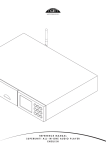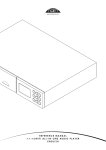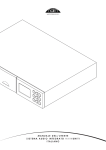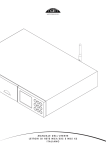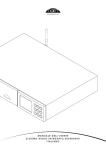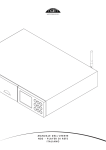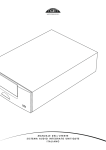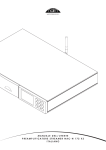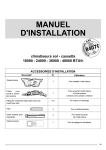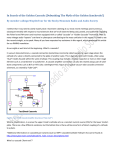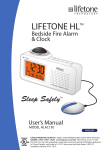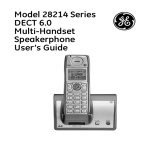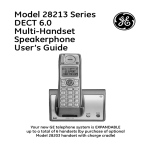Download Naim UnitiQute
Transcript
REFERENCe MANUAL UNITIQUTE ALL-IN-ONE AUDIO PLAYER ENGLISH C onte nts Section Contents 1 UnitiQute Introduction Page 5 UnitiQute Integrated Amplifier 16 5.1 Selecting Inputs 16 1 5.2 Volume Control 16 Amplifier Display 16 1.1 The Integrated Amplifier 1 5.3 1.2 The Multi-mode Radio 1 5.4 Signal Outputs 16 1.3 The UPnP™ Audio Interface 1 5.5 Amplifier Fault Warnings 16 1.4 The USB/iPod Interface 1 6 UnitiQute Multi-mode Radio Tuner 17 2 UnitiQute Installation and Connection 2 6.1 FM Tuner – Seeking Stations 17 DAB Tuner – Seeking Stations 17 2.1 UnitiQute Rear Panel 2 6.2 2.2 Mains Power Connection 2 6.3 iRadio Tuner – Seeking Stations 17 2 6.4 Adding iRadio Stations 18 Storing Radio Presets 18 2.3 FM/DAB Aerial Connection 2.4 Audio Signal Connections 2 6.5 2.5 Speaker Outputs 3 6.6 Using Radio Presets 18 2.6 Headphone Output 3 2.7 Signal Ground Switch 3 7 UnitiQute UPnP™ Audio Interface 19 2.8 USB/iPod Interface 3 7.1 UPnP™ Servers 19 2.9 Network Connections 3 7.2 Audio File Compatibility 19 2.10 Control Socket 4 7.3 Scanning Servers and Playing Files 19 3 UnitiQute Operation 5 8 UnitiQute USB/iPod Interface 20 3.1 Front Panel Features 5 8.1 USB Media and File Compatibility 20 3.2 Front Panel Display (normal play mode) 5 8.2 iPod Compatibility and Charging 20 3.3 Front Panel Display (list mode) 6 8.3 Browsing and Playing USB Files 20 3.4 Front Panel Display (setup mode) 6 3.5 UnitiQute Remote Handset 7 9 UnitiQute Specifications 21 3.6 UnitiQute Text Entry 8 3.7 The n-Stream Control App 8 4 UnitiQute Setup 10 4.1 The Setup Home Menu 10 4.2 The Language Menu 10 4.3 The Inputs Menu 10 4.4 The Speakers Menu 11 4.5 The Headphones Menu 12 4.6 The Network Settings Menu 12 4.7 The Digital Output Menu 13 4.8 The Front Display Menu 13 4.9 The Clock and Alarm Menu 14 4.10 The Handset Keys Menu 14 4.11 The Factory Settings Menu 15 Note: This manual is issue No. 2 and describes the operation of units running software release version 3.9.00. Units running earlier software will not operate fully in the manner described in this manual. The software running in a UnitiQute is displayed in the Factory Settings menu. “Made for iPod” and “Made for iPhone” mean that an electronic accessory has been designed to connect specifically to iPod or iPhone respectively and has been certified by the developer to meet Apple performance standards. Apple is not responsible for the operation of this device or its compliance with safety and regulatory standards. iPod and iPhone are trademarks of Apple Inc., registered in the U.S. and other countries. Windows Media™ is a trademark of Microsoft Corporation. UPnP™ is a trademark of the UPnP™ Forum. Un itiQ u t e Intro du c tio n 1 U n it iQ u t e Introd ucti o n UnitiQute is a highly capable product that will repay time and effort spent on installation and setup. We strongly recommend that you read this manual. UnitiQute effectively incorporates four separate elements. Each of these is introduced in the following paragraphs and subsequently described in full detail in Sections 5 to 8. The UnitiQute elements are: An Integrated Stereo Amplifier Introduced below and fully described in Section 5 A Multi-mode Radio Introduced below and fully described in Section 6 A UPnP™ Audio Interface Introduced below and fully described in Section 7 A USB/iPod Interface Introduced below and fully described in Section 8 Prior to the sections describing UnitiQute’s elements, Section 2 covers its installation and connection, Section 3 describes its operation and Section 4 describes its setup. 1. 1 The Integr ate d Amplif ie r 1.1.1 Inputs UnitiQute incorporates an audio preamplifier that provides two analogue and four S/PDIF digital audio external inputs. The preamplifier also accepts internal inputs from UnitiQute’s integrated FM/DAB tuner. In addition to conventional analogue and digital input signals, the UnitiQute preamplifier can accommodate the following external peripheral inputs: • • iPod and USB storage via a USB interface. Internet radio and universal plug and play (UPnP™) servers via an Ethernet network socket or wireless network connection. 1.1.2 Signal Outputs The UnitiQute DAB module incorporates full broadcast and station display capabilities. The FM module is fully RDS (Radio Data System) capable. Note: DAB and RDS broadcasts are not available in all territories. 1 . 3 Th e UP n P ™ A u d i o I n t er f a ce UnitiQute can connect to a home network and play audio files stored on UPnP™ servers. 1 . 4 Th e US B / i P od I n t er f a ce UnitiQute incorporates a front panel USB interface socket that enables audio files stored on USB memory sticks and Apple iPod models to be selected and played. UnitiQute is Apple compatible with the iPod and iPhone models illustrated below. The UnitiQute preamplifier provides the following signal outputs: • • • An S/PDIF digital audio output (pre volume/balance control). A preamplifier output (post volume/balance control). A headphone output (post volume/balance control). 1.1.3 Speaker Outputs UnitiQute incorporates a stereo power amplifier rated at 30 Watts per channel into 8 Ohms. The power amplifier is designed to drive one pair of speakers via the sockets on the UnitiQute rear panel. 1.2 The Multi-mode Radio The UnitiQute multi-mode radio combines an FM/DAB (Digital Audio Broadcasting) tuner and an internet radio (iRadio) player. A total of 40 radio stations across all three modes can be stored as presets. In FM and DAB mode stations are tuned by UnitiQute scanning the respective transmission bands. In iRadio mode UnitiQute receives data streams and a list of available radio stations from a dedicated internet server. iRadio requires broadband internet access via a home network connection. 1 Un itiQ u t e Insta lla tio n and Connect i on 2 U n it iQ u t e Insta l l a ti o n a nd Connecti on UnitiQute should be installed on an equipment stand intended for the purpose. Do not stand it directly on top of another item of equipment and ensure it is well ventilated. Care should be taken to ensure that it is level. It should be installed in its final location before connecting cables or switching on. UnitiQute has no standby mode and is intended to be left switched on. Connecting UnitiQute to mains power and to a variety of audio peripherals and sources is described in the following paragraphs. Diagram 2.1 illustrates the UnitiQute rear panel connection sockets. 2. 1 UnitiQ ute Re ar P ane l power switch mains input and fuse digital output left speaker right speaker wireless network (WiFi) antenna socket analogue digital inputs input 1 & 3 (coaxial) preamp output signal ground switch digital inputs 2 & 4 (optical) 2. 2 Mains P owe r C o nne c tio n Connect UnitiQute to a mains power socket using either the mains cable supplied or a Naim Power-Line. 2. 3 FM/D A B A e rial C o nne c tio n In order to enable high quality FM and DAB radio, UnitiQute requires a, strong, interference-free radio signal. Its rear panel FM/DAB Aerial socket must be connected, via 75 Ohm low-loss coaxial cable, to a suitable aerial. The aerial should be mounted clear of large obstructions and as high as possible; ideally on a roof. Note: Your local retailer should be able to offer advice on a suitable aerial and aerial installer. DAB/FM aerial socket network socket RS232 socket 2 . 4 A u d i o S i g n a l C on n ect i on s 2.4.1 Audio Signal Inputs UnitiQute provides one USB input socket, two stereo analogue inputs and five S/PDIF digital inputs including one combined analogue/digital input socket. Connection to the inputs is made via a variety of socket types. The following table lists the inputs and their socket type: Input rear panel front panel dig. 1 dig. 2 dig. 3 dig. 4 USB Type Analogue Analogue Digital Digital Digital Digital Digital Digital Socket RCA phonos 3.5mm jack 3.5mm mini-TosLink jack Coaxial (RCA phono) Optical (TosLink) Coaxial (RCA phono) Optical (TosLink) USB Type A Note: The front panel analogue/digital jack socket can accept both conventional analogue 3.5mm plugs and mini-TosLink optical digital plugs. It will automatically identify the type of plug inserted and handle the signal appropriately. Always use high quality interconnect cables to connect sources to UnitiQute inputs. 2 Un itiQ u t e Insta lla tio n and Connect i on 2 . 7 S i g n a l G r ou n d S w i t ch 2.4.2 Audio Signal Outputs UnitiQute provides audio signal outputs for a variety of applications. Connections to the outputs are made via the socket types listed in the following table: Output Digital Preamplifier Type Digital S/PDIF Analogue stereo Socket 75Ω BNC RCA phono Note: The digital output is intended for connection to a digital to analogue converter or preamplifier incorporating digital inputs so that UnitiQute can be used as a digital source device for an existing system. The output can be switched on and off from a setup menu. See Section 4.7. External analogue inputs to UnitiQute are not available from the digital output. Note: The digital output is taken before the UnitiQute volume and balance controls so the output signal will not reflect UnitiQute volume and balance control or mute function. The output always reflects the selected digital input signal. Note: The preamplifier output is taken after the UnitiQute volume and balance controls so peripheral equipment connected to it will respond to UnitiQute volume and balance control changes. The output always reflects the selected input signal. 2. 5 S peaker Outputs A set of stereo speaker connection sockets is provided on the UnitiQute rear panel. Custom Naim Audio loudspeaker connectors are supplied to make the connection and in order to comply with current European safety regulations these should always be used. Naim Audio speaker cable will provide the best results, however, a range of speaker cable types may be used without risk of damage to the amplifier. Contact your local Naim retailer for further advice. Use equal lengths of speaker cable for each channel. Ensure when connecting speakers that they are “in phase”. That is, the positive and negative connection orientation at both the speaker and amplifier ends of the cable is the same for both channels. 2. 6 Headphone O utput UnitiQute is fitted on its front panel with a 3.5mm stereo headphone socket. Insertion of a headphone plug will mute the speaker and preamplifier outputs. Note: UnitiQute controls and stores volume settings separately for headphones and speakers. UnitiQute is fitted on its rear panel with a Signal Ground switch offering two positions: Chassis or Floating. Select the Chassis position unless UnitiQute is connected in a hi-fi system incorporating another earthed source component, or mains “hum” is audible through the loudspeakers. Contact your retailer, distributor or Naim for advice if necessary. Note: “Connected” in the context above means an analogue audio signal cable that includes an earth connection. The UnitiQute digital inputs and output are isolated from the mains earth regardless of the Signal Ground switch. Note: All Naim CD players are earthed so the Signal Ground switch should be set to floating if one is connected in the system. No damage will be done if the wrong Signal Ground position is chosen, however the system sound quality may be compromised. Note: The UnitiQute negative analogue input and output connections for each channel are common. The mains earth (ground) should always be connected regardless of what other equipment is used. The mains earth primarily grounds the case and the electrostatic screen within the transformer, and is only connected to the signal negative if the Signal Ground switch is set to Chassis. In order to avoid hum loops, the signal negative of the whole system should be connected to the mains earth in one place only. 2 . 8 US B / i P od I n t er f a ce UnitiQute is fitted with a front panel USB interface intended for the connection of Apple iPod models and USB memory sticks carrying audio files. The USB interface should not be used for any other purpose. Depending on the setup options chosen (see Section 4.3.5), iPod batteries will be charged when connected to the USB interface. 2 . 9 N et w or k C on n ect i on s 2.9.1 Wired Network Connection UnitiQute is fitted on its rear panel with a standard RJ45 Ethernet socket. This socket enables UnitiQute to join home networks via a network router to access internet radio data streams or to play audio files stored on appropriately configured UPnP™ servers. Ethernet-over-mains hardware may be used and provides a simple and convenient method of wired home network connection. However, depending on mains wiring factors specific to each home environment, the presence of network data on the mains supply may compromise overall system sound quality. If any sound quality compromise is found to be unacceptable, dedicated network cabling should be installed or wireless networking should be employed. 3 Un itiQ u t e Insta lla tio n and Connect i on 2.9.2 Wireless Network Connection If UnitiQute is to connect wirelessly to the home network the supplied Wi-Fi antenna must be fitted to the rear panel wireless antenna socket. Wireless configuration will also be necessary before UnitiQute is able to connect to the network. See Section 4.6.1 of this manual. 2.9.3 Network Settings UnitiQute is set up when originally shipped not to require any on-site network configuration but to connect to a network automatically (it uses DHCP by default). However, if your UnitiQute has been previously used, its network configuration may have been altered leaving it unable to connect automatically. If this appears to be the case ensure that DHCP is selected in the Network Settings menu and re-start UnitiQute. If problems still persist contact your retailer, installer or Naim Audio directly. See Section 4.6. Note: Before reporting network connection problems carry out a Factory Reset operation and try again. Select Reset All Settings from the Factory Settings setup menu. See Section 4.11. Note: A UnitiQute switched on without a working wired network connection will only be able to connect to a home network wirelessly. To use an Ethernet (wired) connection, switch UnitiQute off, connect the network and switch it on again. Note: For internet radio to operate UnitiQute requires connection to a broadband internet service via a router/ modem with a built-in firewall. 2. 1 0 Control S o c ke t UnitiQute is fitted on its rear panel with a standard RS232 interface socket. This socket is intended to enable firmware upgrades and diagnostic tests to be carried out. Contact your retailer, distributor or Naim for more information if required. 4 Un itiQ u t e O p er a tio n 3 UnitiQute Operation UnitiQute is operated from the supplied remote handset. Setting up and operating UnitiQute requires navigation through a menu-driven user interface. The general principles of the interface are carried across each of UnitiQute’s elements so this section of the manual describes and illustrates those general principles. 3. 1 Front P ane l F e ature s touch to mute/un-mute headphone output combined analogue and digital input USB interface 3.2 Front Panel Display (normal play mode) 42 P1 iRAD Fluid Svarte Greiner - Erik K S In normal play mode the UnitiQute screen provides a variety of information on the current setup, the input selected and the material playing. A typical normal play mode screen is illustrated above showing an iRadio station called Fluid playing programme by Svarte Greiner. The radio station has been saved as Preset 1. At the top left of the screen volume level 42 is displayed along with a “speaker” icon that shows UnitiQute is not muted. 5 Un itiQ u t e O p er a tio n 3. 3 Front P ane l D isplay (list mo de ) DAB Stations 1/28 4BBC R1 BBC R2 BBC R3 BBC R4 Setup 1/9 4Language Inputs Speakers Headphones List mode is entered by pressing the handset ok/list key and can be used where sources provide data that can be browsed: a list of radio stations or tracks for example. Setup mode is entered by pressing the handset setup ( ) key. It provides access to all user-configurable UnitiQute parameters. Lists displayed will depend on the input selected and data available. A typical list mode screen is illustrated above showing the DAB radio stations available with BBC R1 selected. The screen illustrated above is the setup home screen that is always displayed when setup mode is entered. The “1/9” at the top right denotes that the selected item is number one of nine. At the top right of the screen, “1/28” denotes that the selected item is number one of twenty-eight. To navigate around the setup menus and make selections use the handset up (5), down (6) and left (3) arrow keys to navigate around menus and the ok/list key to confirm a selection. To scroll up and down lists and select items use the handset up (5) and down (6) keys and ok/list buttons or keys. To return to normal display press the handset exit key. Note: The right (4) key duplicates the ok/list key when navigating list mode menus. In long item lists the handset numeric/text keys can be used to jump through the list alphabetically. 6 3 . 4 Fr on t P a n el Di s p l a y ( s et u p m od e) Note: The right (4) key duplicates the ok/list key when navigating setup mode menus. To exit setup mode press the exit key or setup ( ) key. UnitiQute setup is covered in Section 4. Note: If programme material is playing when UnitiQute enters setup mode it will continue to play. The volume, mute and transport (play, pause, stop etc.) keys on the handset will remain operational. Un itiQ u t e O p er a tio n 3. 5 UnitiQ ute Re mo te H andse t The handset key functions are listed and described in the tables below. Some keys change function when UnitiQute is in list/setup mode. Normal play mode functions are denoted by the text on each key and list/setup mode functions are denoted by the text below each key. Keys with only one function are listed in the table on the right. The supplied remote control handset is a multifunctional device designed specifically for Naim Uniti Series products. To fit batteries, remove the battery cover and insert the batteries into the body taking care with their orientation. Replace the battery cover. 3.5.1 Normal and List/Setup Mode Keys 3.5.2 Normal Play Mode Keys Key Normal Mode List/Setup Modes Key Numeric text Enter digits 1 to 9 Enter characters in text 0 Enter 0 (zero) preset del store £ Enter spaces in text Display the radio Delete last preset list character in text Display the radio Switch text case preset menu input+ Select next input Menu up 5 navigation input- 6 Select previous input Menu down navigation 3 Input dependent (see note) Previous menu or back one character in text Input dependent (see note) Next menu or forward one character in text 4 exit No function list ok Exits current menu without saving changes Display input Confirm action dependent list of or selection tracks/functions Note: Navigation (3456) key assignments can be altered via the Handset Keys setup menu. See Section 4.10. disp @# abc def ghi jkl mno pqrs tuv wxyz preset dispSwitches UnitiQute display on or off. Toggles clock display if configured. vol + Increase volume vol – Decrease volume mute Silences UnitiQute store (repeat)Repeat selected track, programme or playlist mute (shuffle) del input + vol + Function (setup) ok list exit vol - cd radio pc iPod tv av hdd aux Display the setup menu (info)Cycle through secondary input information (play/pause) input - Play tracks randomly from list Play or pause track (previous) Go to previous track/station (next) Go to next track/station (stop) Stop track (reverse) Fast reverse track (forward) Fast forward track cdSelects the rear panel Analogue input radioSequentially selects the FM, DAB and iRadio inputs pcSelects the UPnP™ input iPodSequentially selects the USB/ iPod and front panel inputs tvSelects the Digital 1 input avSelects the Digital 2 input hddSelects the Digital 3 input auxSelects the Digital 4 input Note: Input selection key assignments can be altered via the Handset Keys setup menu. See Section 4.10. 7 Un itiQ u t e O p er a tio n 3. 6 UnitiQ ute T e x t Entry 3 . 7 Th e n -S t r ea m C on t r ol A p p Some UnitiQute menu screens require text entry - naming inputs for example. Text entry is carried out using the handset numerical buttons in a manner similar to mobile phone SMS text entry. When text entry is required, multiple presses of a key will scroll through the characters associated with that key. In addition to characters, the preset key provides a delete function, the zero key provides a space and the store key provides letter case change. The up (5) and down (6) keys will also scroll through all the available letters. The enlarged handset image illustrates the number keys and the characters associated with each. When prompted on a UnitiQute screen to enter text, select characters in turn by pressing each appropriate key the required number of times. Confirm the text entry by pressing the ok/list key. disp @# ghi abc jkl def mno The n-Stream control application is available from the iTunes App Store. n-Stream is compatible with iPad, iPhone and iPod touch models running iOS software Version 3.1.3 or later. 3.7.1 n-Stream Setup To begin using n-Stream to control your UnitiQute you must first install the app on your iPad, iPhone or iPod touch. With the app installed and the iPad, iPhone or iPod wirelessly connected to the same network as your UnitiQute, start the app by touching its screen icon. Selecting setup opens a menu that enables the UnitiQute to be selected for control. Touch the appropriate UnitiQute as identified by its network address or device name; Qute-C1C3 and 192.168.001.064 respectively in the illustration above. Note: Your UnitiQute network address and device name can be found in its Factory Settings setup menu. Note: The UnitiQute name can be changed from its setup menu. Doing so can enable individual units in a multiple installation to be identified more easily. The setup menu enables the following options to be selected: pqrs tuv preset wxyz store del input + vol + mute Auto connection:Select ON for automatic connection to the UnitiQute whenever the n-Stream app is running. Stay connected:If OFF is selected, the n-Stream app will “sleep” following a preset period of inactivity. Selecting ON will force n-Stream to remain continuously active. Note: Continuous connection of n-Stream may result in your iPad, iPhone or iPod battery draining. Use Hi-Fi Language:Select ON for the n-Stream app to reflect the selected UnitiQute display language. If NO is selected the n-Stream app will display in the default iPad, iPhone or iPod language. ok list exit vol input 8 Clear Image Cache:Deletes album artwork images stored by the n-Stream app. Un itiQ u t e O p er a tio n 3.7.2 Using n-Stream The n-Stream app is based on three main screens. The Inputs screen, the Playing screen and the Library screen. These screens are selected by touching the icons at the top of the display. The inputs screen enables selection of UnitiQute inputs. Input names reflect those specified in the UnitiQute input setup menus (See Section 4.3). Selecting Allegro Media Server followed by items in the subsequent lists enables the selection of playlists, albums or individual tracks for playback. The Playing and Library screens for other inputs follow the same protocol of item selection. The Playing screen displays the currently playing item and provides appropriate transport controls. When a Radio station is playing an icon is also provided to open a preset station menu through which presets can be either stored or recalled. The Library screen displays lists of playback items available to the selected UnitiQute input. The adjacent illustration shows Allegro Media Server is available to the UnitiQute UPnP™ input. Note: Allegro Media Server is an application that makes iTunes songs and playlists available to UPnP™ players. 9 Un itiQ u t e Setu p 4 U n it iQ u t e Setup Once UnitiQute is installed with mains power, speakers, a radio aerial and any external input connections made, it can be switched on and set up for use. The degree to which you modify UnitiQute’s default settings will depend upon the uses to which you put it and the extent to which you use its capabilities. It may be that you have no need to modify the default settings at all, however we would encourage you to read this section of the manual in order that you gain a full understanding of UnitiQute’s abilities. The following paragraphs describe each UnitiQute setup menu in turn starting with the setup home menu. Enter UnitiQute setup mode by pressing the handset setup ( ) key. Navigate around the setup menus using the handset arrow keys and make selections using the ok/list key. Exit setup by pressing the exit key. 4. 1 The S etup H o me M e nu The UnitiQute setup home menu provides access to ten setup menus. The function of each menu is as follows: Setup 4 . 2 Th e L a n g u a g e M en u 1/10 4Language Inputs Speakers Headphones Language:Enables the UnitiQute user interface language to be changed. Inputs:Enables various parameters for each internal and external input to be configured. Speakers:Configures UnitiQute speaker output options. Headphones:Configures UnitiQute headphone output options. Network Settings:Configures UnitiQute network connection settings. Digital Output:Configures UnitiQute digital output settings. Front Display: Configures UnitiQute display features. Clock & Alarm: Configures the clock and alarm. Handset Keys:Enables UnitiQute inputs to be assigned to specific handset keys. Also enables configuration of the handset navigation (3456) keys. Factory Settings:Enables interrogation of UnitiQute status, deletion of all user presets and return to factory default settings. Each of the ten setup menus is described in detail in the following sections. Use the handset up (5) and down (6) and ok/list keys to select a setup menu. 10 The Language setup menu enables the UnitiQute user interface language to be changed. Enter setup mode Language 1/6 4English Deutsch Français Español and use the handset ok/list key to select Language. Use the handset up (5) and down (6) and ok/list keys to select a language. Exit setup mode by pressing the handset exit key. 4 . 3 Th e I n p u t s M en u The Inputs setup menu enables a variety of parameters to be specified for each UnitiQute internal source and external input. These parameters define how control of UnitiQute inputs behaves. The options available for each are described in the following sections. Three parameters are common to all inputs: Select Input 1/11 4FM DAB iRadio UPnP FM 4Enabled: Name: Input Trim: Seek Lock: 1/4 Yes FM 0 Medium Enabled: Switches the input on or off and displays or hides any associated menus. Name: Enables user specified names to be attached to inputs. Use the handset to enter text. Input Trim: Enables the relative level of each input to be adjusted so that each is of an approximately equal volume. Adjust using handset 6 or 5 key. 4.3.1 FM Input FM 4/4 Parameter Options Enabled: Yes Name: FM Enabled: Yes / No Input Trim: 0 Name:User definable 4Seek Lock: Medium Input Trim:±10dB Seek Lock:Low / Medium / High. Sets the FM signal strength required for the UnitiQute tuner to identify an FM station. Un itiQ u t e Setu p 4.3.2 DAB Input DAB Parameter Options Enabled: Yes / No Name:User definable Input Trim:±10dB Re-scan Stations:Re-scans for DAB stations. Enabled: Name: Input Trim: 4Re-Scan Stations 4/4 Yes DAB 0 Note: The UnitiQute DAB input is not implemented in units distributed in territories where Digital Audio Broadcasting is unavailable. 4.3.3 iRadio Input iRadio 4/5 Parameter Options Enabled: Yes Name: iRadio Enabled: Yes / No Input Trim: 0 Name: User definable 4Auto Disconnect: Never Input Trim:±10dB Auto Disconnect:Select time. Auto-disconnect is provided so that internet data usage limits are not inadvertently exceeded by a UnitiQute left connected to internet radio. Browse History:Yes / No. If Yes is specified UnitiQute will display the last used station if it is available when list mode is selected. If No is specified UnitiQute will display the top station selection menu. 4.3.4 UPnP™ (Network) Input UPnP 3/4 Parameter Options Enabled: Yes Name: UPnP Enabled: Yes / No 4Input Trim: 0 Name:User definable Server History Yes Input Trim: ±10dB Server History:Yes / No. If Yes is specified UnitiQute will remember the last used folder if the UPnP™ server is still available. If No is specified UnitiQute will display the full list of available servers. 4.3.5 USB/iPod Input Parameter Options USB/iPod 4/5 Enabled: Yes Name: USB/iPod Input Trim: 0 4Folder History: No Enabled: Yes / No Name:User definable Input Trim:±10dB Folder History:Yes / No. If Yes is specified UnitiQute will automatically display the last used folder on the USB device. If No is specified the top level folder of the device will be displayed. Charge:Always / Never. iPod battery charging takes place always when the iPod is connected or never takes place. Note: The non-charging option is provided because there is a small reduction in iPod sound quality when simultaneously charging and playing. This means however that an iPod can potentially run out of power while playing via the UnitiQute. 4.3.6 Front Panel Input Front 4/4 Parameter Options Enabled: Yes Name: Front Enabled: Yes / No Input Trim: 0 Name:User definable 4Format: Auto Input Trim:±10dB Format:Auto / Analogue / Digital. If Auto is specified the front panel input will automatically detect the audio signal format (analogue or digital) and configure the input appropriately. Specifying Analogue or Digital will fix the front panel input format. 4.3.7 Rear Panel Digital Inputs Parameter Enabled: Name: Input Trim: Options Yes / No User definable ±10dB 4.3.8 Rear Panel Analogue Input Digital 1 4Enabled: Name: Input Trim: Analogue 1/3 Yes Digital 1 0 1/4 Parameter Options 4Enabled: Yes Enabled: Yes / No Name: Analogue Input Trim: 0 Name: User definable AV Fixed Volume No Input Trim: ±10dB AV Fixed Volume:Yes / No If No is selected the input will behave normally. If Yes is selected the input will operate at a fixed volume and the UnitiQute volume control will be disabled. This enables UnitiQute to be used in multichannel AV systems with volume control handled by the AV processor. Take care when selecting AV Fixed Volume. 4 . 4 Th e S p ea k er s M en u The Speakers setup menu enables a variety of speaker parameters to be adjusted. The options are tabulated and described in the following sections: Speakers 4Type: Loudness: Max. Volume: Balance: 1/4 Large No 100 0 Parameter Options Type:Large / Small / None Loudness: Yes / No Max. Volume:0 to 100 (adjust using handset 6 or 5 keys) Balance:-10 to + 10 (adjust using handset 6 or 5 keys) The speaker type options specify high-pass filtering settings. Select the Large option when the UnitiQute preamplifier output is connected to an external power amplifier or to a subwoofer used to augment the low frequency performance of large (full bandwidth) speakers. Select Small only when the UnitiQute preamplifier output is connected to a subwoofer used to provide the low 11 Un itiQ u t e Setu p frequency component of a speaker system incorporating small (restricted bandwidth) satellite speakers. When Small is specified, a 100Hz high-pass filter is applied to the UnitiQute speaker output signal. Select None when no speakers are connected directly to the UnitiQute Engaging the Loudness option applies low frequency boost to the speaker and preamplifier outputs that decreases as the volume setting is increased. Through compensating for the ear’s reduced low frequency sensitivity at low volume levels, the Loudness function can make low volume listening more satisfying. Note: The loudness contour operates at volume settings between 0 and 55. The speaker Max. Volume and Balance parameters specify maximum allowed volume, and the channel balance respectively. 4. 5 The Headpho ne s M e nu The Headphones setup menu enables the Max. Volume parameter to be specified: Headphones 1/1 4Max. Volume: 100 Parameter Options Max. Volume:0 to 100 (adjust using handset 6 or 5 keys) 4.6 The Network Settings Menu The Network Settings menu enables UnitiQute network parameters to be customised to suit the router and network. The options are tabulated and described in the following sections: Network Settings 1/4 4Name: Uniti-0131 Wireless: Not Used Status: Not Connected DHCP Yes Parameter Options Name: User definable (text entry) Default: Uniti-xxxx Wireless: Not Used / Wireless Network Names Status:Connected / No Signal / Login Failure / Busy / Etc. DHCP: Yes / No The Name parameter enables the UnitiQute’s default network name to be changed. The Wireless parameter enables a wireless network to be chosen and joined. See Section 4.6.1 below for detailed wireless set up notes. Network Status displays the current network connection status. The DHCP parameter enables the UnitiQute network settings to be modified. In most cases, specifying Yes and leaving UnitiQute set to DHCP, will be the appropriate 12 option. See Section 4.6.2 below for notes on non-DHCP network connection. Note: Devices installed on a network have an IP address through which they are identified by all the other items on the network. DHCP is a set of rules that enable the automatic allocation of addresses as items are connected (or switched on while connected) to the network. UnitiQute is set up by default to use DHCP. Note: If UnitiQute is connected to the network both wirelessly and via Ethernet (wired), the Ethernet connection will take priority. 4.6.1 Wireless Network Connection Set Up Select Network 3/6 <Don’t Use Wireless> LingNet 4GreenNet TomNet If the Wireless parameter is selected in the Network Settings menu the Select Network menu will display a list of the available networks. An option not to use a wireless connection is also provided. Use the handset up (5) or down (6) keys to scroll through the list and the ok/list key to select a network. Note: UnitiQute is compatible with most commonly used Wi-Fi standards. Routers that support 802.11b and 802.11g will work, however those with 802.11n compatibility are recommended for best results. Note: As with any wireless network hardware, UnitiQute connection reliability will be affected by both network router performance and Wi-Fi signal quality. To minimise the possibility of poor connection reliability, UnitiQute should be connected to network audio sources by no more than one wireless “leg”. Other “legs” necessary between UnitiQute and the network audio sources should be wired. Note: UnitiQute cannot connect to a “hidden” wireless network. If the selected network is secure and requires a passphrase or access key to join, UnitiQute will display an alert message. Pressing the handset ok/list key will then open a text entry screen for entry of the passphrase or access key. Use the handset numeric/text keys to enter the passphrase or access key taking care to ensure that the letter case is correct. Press the handset ok/list key when text entry is complete. In the illustration the passphrase is “flatfish”. If the network is successfully joined UnitiQute will display a confirmation screen. Now enter your wireless passphrase or access key. Press OK to continue flatfish abc flatfish| Press OK to confirm Connected Press OK To Finish Un itiQ u t e Setu p If an incorrect passphrase or access key is entered UnitiQute will display an alert message. Can’t Login Press OK To Re-Try Note: As a security measure, a router may also require the UnitiQute’s MAC address to be entered before allowing it to join the wireless network. This type of security feature is known as ‘MAC address filtering’. The UnitiQute MAC address is shown in the ‘Factory settings > System Status’ page. Note: The wireless passphrase/access key is created when the wireless router is first set up and could be a word or a series of numbers and letters. If the passphrase/access key is not known, check on the router settings page or with the person who initially set up the router. Note: If WEP security is used the router should be set to “auto” or “open” authentication. This wireless network is insecure and requires no passphrase or access key. Press OK To Connect Note: Wireless connection difficulties can sometimes be resolved by changing the wireless connection channel in the router settings. 4.6.2 Non-DHCP (Static) Network Connection If DHCP is de-selected in the Network Settings menu, five further parameters will be displayed. Network Settings 4IP: Mask: Gtwy: DNS1: Parameter Options IP:User definable (numerical Default: 192.168.0.80 Mask: User definable (numerical Default: 255.255.255.0 Gateway (Gtwy): User definable (numerical Default: 192.168.0.1 DNS1: User definable (numerical Default: 192.168.0.1 DNS2: User definable (numerical 4.7 The Digital Output Menu The Digital Output setup menu enables the UnitiQute digital output to be switched on and its signal format configured. Digital Output 4Enabled: Output: 1/2 No Native Parameter Options Enabled: Yes / No Output:Native / 96kHz 24bit If Native is selected, the digital output format will reflect the input format. If 96kHz 24bit is selected, the output is re-sampled to 96kHz and 24bit resolution. 4.8 The Front Display Menu Note: If a router offers multiple security configurations, UnitiQute will automatically offer only the most secure one. If the selected network is insecure and requires no passphrase or access key to join, UnitiQute will display an alert message. Pressing the handset ok/list key will immediately connect UnitiQute to the network and display a confirmation screen. settings. Consult your network router’s user documentation for help with specifying fixed IP address settings. 1/5 192.168.0.80 255.255.255.0 192.168.0.1 192.168.0.1 entry) entry) entry) entry) entry) The Front Display setup menu Front Display 1/5 enables the behaviour of 4Off During Mute: No the front panel display, logo Auto Off: 2 mins illumination, clock display Clock When Off: Yes Logo Off: If Muted and logo touch-muting to be modified. The options are tabulated and described in the following section: Parameter Off During Mute: Auto Off: Clock When Off: Logo Off: Logo Mute: Options Yes / No Select time from list Yes / No If Muted / If Display Off / Always / Never Yes / No When Off During Mute is selected the front panel display will switch off when mute is engaged. Auto Off defines the length of time the display will remain switched on after the last interface operation is carried out. Time periods of between 10 seconds and 1 hour can be selected. Note: If the display has been switched off using the handset disp key this setting will take priority over the Auto Off setting. The display will always switch on briefly when control commands are received. The Clock When Off settings enables the clock to remain displayed when other display settings are switched off. Note: If Clock When Off is set to “Yes” and Logo Off is set to “If Muted”, the clock display will dim automatically 10 seconds after mute is selected. The Logo Off settings select the circumstances in which the front panel logo illumination will switch off. Logo Mute settings engage or disengage the touch-mute function of the front panel logo. Default: 192.168.0.1 These settings enable UnitiQute to connect to a network using a fixed IP address. On selecting each one in turn, numerical entry screens will be displayed that require completion with the appropriate network IP address 13 Un itiQ u t e Setu p 4. 9 The Clock and Alarm M e nu The Clock & Alarm setup menu enables the UnitiQute clock to be set and alarms to be configured. Selecting Set Weekday Alarm or Set Weekend Alarm opens a menu that offers the following parameters and options: Clock & Alarm 1/5 4Set Weekday Alarm Set Weekend Alarm Adjust Time Zone Resync Time From Net Parameter Options Weekday Alarm 1/4 Enabled:Yes / No. 4Enabled: No Selecting Yes Alarm Time: 07:00 Input: Fluid Radio primes the Volume: 30 alarm. Selecting No disables the alarm. Alarm Time:07:00. Selecting the time opens a screen that enables the alarm time to be set by using the remote navigation (5 6 3 4) and numeric keys. Input:UnitiQute external inputs or radio presets can be selected to become the alarm audio source. Note: The UnitiQute radio can only be used as an alarm signal using stored radio presets. Volume:30. The alarm audio volume can be set independently of the default UnitiQute volume using the remote handset up (5) and down (6) keys. Weekday alarms operate on Mondays to Fridays. Weekend alarms operate on Saturdays and Sundays. Note: The UnitiQute has no default alarm tone and can only use its external inputs or radio presets as alarm signals. If the use of an alarm is critical, it is important to be certain that the alarm signal will be active when the alarm is set to sound. This is especially relevant to internet radio stations which may cease to broadcast unexpectedly. Selecting Adjust Time Zone enables the time zone within which the UnitiQute is located to be set. The handset up (5) and down (6) keys are used to select + or – with respect to GMT (Greenwich Mean Time). Time Zone ±00:00 Now: 12:04 Mar 16th 2011 Note: The UnitiQute clock does not adjust automatically to take account of localised “daylight saving” time changes. Use the Adjust Time Zone function to advance or retard the clock as appropriate. Selecting Resync Time From Net enables the UnitiQute clock to re-synchronise with its specified time server. Note: The UnitiQute clock re-syncs with its internet time server automatically every 24 hours. If it is unable to connect it retries s every 30 minutes. 14 Selecting Advanced Setup enables an alternative internet time server to be specified. Contact your local Naim retailer for more information on selecting time servers. 4 . 1 0 Th e H a n d s et K ey s M en u The Handset Keys setup menu enables the UnitiQute inputs assigned to each handset input selection key (Diagram 4.10.4) to be changed, and the function of the handset navigation keys (Diagram 4.10.3) to be configured. 4.10.1 Navigation Key Functions Handset Keys 4Up/Down 1/10 Left/Right CD Radio Up/Down Actions 1/2 4Input Off Selecting the Up/Down Actions parameter from the Handset Keys menu opens a further menu that enables the selection from two modes of handset up (5) and down (6) key function: Input and Off. If Input is selected the keys will select inputs and if Off is selected the keys will be disabled in respect of input selection. Selecting the Left/Right Actions Left/Right 1/4 parameter from the Handset Keys 4iPod Track menu will open further menus Radios Station enabling the configuration of USB Track the left (3) and right (4) keys UPnP Track independently for the USB/iPod, Radios, and UPnP™ inputs. The 1/3 options available for the USB/iPod Left/Right Actions 4Track and UPnP™ inputs are Track, List List and Off. If Track is selected the Off left (3) and right (4) keys will select the previous or next track. If List is selected the keys will return UnitiQute to list mode, and if Off is selected the keys will be disabled in terms of track or list mode selection. The options available for the Left/Right Actions 1/4 Radios input are Station, Preset, 4Station List, and Off. If Station is selected Preset the left (3) and right (4) keys List Off will select the next or previous station. If Preset is selected the keys will select the previous or next stored station preset. If List is selected the keys will return UnitiQute to list mode, and if Off is selected the keys will be disabled in terms of station, preset or list selection. ok list Un itiQ u t e Setu p 4.10.2 Input Key Assignments Handset Keys Up/Down Each handset input selection key may have up to four inputs assigned to it. The default assignments are shown in the following table: Handset Key cd: radio: pc: iPod: tv: av: hdd: aux: 4/10 input - Keys 4.10.4 Handset Input Selection The input selection keys (cd, radio, pc, iPod, tv, av, hdd, aux) are located beneath the transport keys ( ). Left/Right CD 4Radio UnitiQute Inputs Assigned Analogue FM, DAB, iRadio UPnP™ USB/iPod, Front Digital 1 disp Digital 2 Digital 3 Digital 4 Beneath the Up/Down keys and Left/Right keys parameters the Handset Keys menu displays a @# abc Inputs On:Radio 1/4 41. FM def 2. DAB 3. iRadio 4. Unassigned list of the eight handset input keys. Selecting one of the keys then displays a list of the four existing assignments to thatjkl ghi mno key (including unassigned). To change an assignment, select the assignment number to be altered and, from the subsequent menu, select the desired input. pqrs tuv 4.10.3 Handset Navigation Keys wxyz preset storearound the The navigation (3456) keys are located ok/list key. exit vol - del input + vol + mute cd radio pc iPod tv av hdd aux 4 . 1 1 Th e Fa ct or y S et t i n g s M en u The Factory Settings setup menu enables UnitiQute’s system status information to be displayed, handset commands to be analysed, its radio presets to be deleted and its default settings to be restored. The options are tabulated and described below: Factory Settings 1/4 4System Status Handset IR Monitor Clear All Presets Reset All Settings Parameter Options System Status: Select to display Handset IR Mon.: Select to display Clear All Presets: Yes / No Reset All Settings.Warning displayed: Resetting to factory defaults. You will lose ALL user settings. Press front panel Logo to continue. ok list exit vol input - 15 cd radio pc iPod Un itiQ u t e Integr a ted Ampl i fi er 5 U n it iQ u t e Integ ra te d A mp l i fi er UnitiQute incorporates a high performance integrated preamplifier and power amplifier based on established Naim design principles. The preamplifier is able to handle both analogue and digital audio signals and, in addition to UnitiQute’s multi-format radio, network interface and USB/iPod interface it has two external analogue and five external digital inputs. Using the UnitiQute amplifier is simply a matter of selecting the desired input and setting the listening volume level. 5. 1 S electing I nputs Inputs can be selected by pressing the handset up (5) and down (6) keys or one of the handset input selection keys. Note: The front panel input is automatically selected as soon as a plug is inserted. Pressing handset up (5) and down (6) keys scrolls through and selects the inputs in the following order: Analogue, Digital 1, Digital 2, Digital 3, Digital 4, FM (radio), DAB (radio), iRadio, UPnP™ (Network UPnP™), USB/iPod, Front (front panel analogue/digital). Note: These are the default input names. They may be altered within the UnitiQute set up menus. See Section 4.3. Inputs can also be disabled so that they are hidden from selection. Pressing one of the handset input selection keys either directly selects a single input or scrolls through a group of inputs. For example, by default, pressing the CD input selection key selects the Analogue input, while pressing the radio input selection key scrolls through a group comprising the FM, DAB and iRadio inputs. Note: The default input selection key assignments may be altered within the UnitiQute set up menus. See Section 4.10.2. Selecting an input will route that input’s audio signal to the UnitiQute outputs. UnitiQute will momentarily display input names as they are selected before displaying input specific information; iPod track or radio preset for example. If an input is not operational (for example, no USB memory stick is attached) when selected, UnitiQute will display a descriptive alert message. 5. 2 V olume C o ntro l UnitiQute volume control is achieved by using the handset vol– and vol+ keys or by continuously touching the front panel Naim logo (the first touch increases volume, the second touch decreases volume). The volume control affects the speaker, headphone and preamplifier outputs. Note: Switching off the Logo Mute function (see Section 4.8) will also switch off Logo volume control 16 The mute function silences the UnitiQute speaker, headphone, and preamplifier outputs and is engaged or disengaged by touching the front panel logo or pressing the handset mute key. Mute is indicated by the display volume icon flashing. 5 . 3 A m p l i f i er Di s p l a y In normal operation the UnitiQute front panel display primarily shows information relating to the selected input. It will change temporarily to show amplifier adjustments such as volume level and signal mute state as these are made. 5.4 Signal Outputs In addition to its speaker outputs the UnitiQute integrated amplifier provides a preamplifier output, a digital output and a headphone output. The preamplifier output is designed to enable an upgrade or additional power amplifier, or an active subwoofer to be connected. The appropriate output configuration must be selected through the Speakers setup menu. See Section 4.4. The digital output enables UnitiQute sources to be connected to an external digital to analogue converter or preamplifier with digital inputs. External analogue sources (front Analogue and rear Analogue inputs) are not available via the Digital Output. The digital output signal format can be configured via the Digital Output setup menu. See Section 4.7 Note: Although the UnitiQute FM radio is fundamentally an analogue source, the multi-mode radio module digitises FM signals to make them available via the digital output. The UnitiQute headphone amplifier is able to drive most commonly available headphones. Insertion of a headphone plug will mute the UnitiQute speaker and preamplifier outputs. 5 . 5 A m p l i f i er Fa u l t W a r n i n g s In the unlikely event that the UnitiQute power amplifier is overloaded, exceeds its normal operating temperature or malfunctions, its output will mute and the display will show a warning message. Un itiQ u t e M u lti-m o de Rad i o Tuner 6 U n it iQ u t e M ul ti -mod e Rad i o Tun er UnitiQute incorporates a multi-mode radio tuner able to receive FM and DAB transmissions and internet radio streams. FM and DAB operation requires an appropriate aerial to be connected to the rear panel aerial input. Internet radio requires UnitiQute to be connected to a broadband internet service via a network router that incorporates an appropriate firewall. UnitiQute is able to store a total of forty station presets (favourites) across all three tuner modes. Select the FM, DAB or iRadio input to begin. 6. 1 FM Tuner – Se e king Statio ns To find FM stations press the handset prev ( ) or next ( ) keys and the tuner will scan the FM band locking on to and stopping at stations that exceed a specific signal strength. handset numeric/text keys can be used to jump through the list alphabetically. FM 42 BBC R4 92.9MHz 6 . 3 i R a d i o Tu n er – S eek i n g S t a t i on s Note: The interlocked circle icon at the top right of the display indicates a stereo signal. Note: The signal strength lock threshold may be altered within the UnitiQute set up menus. See Section 4.3.1. If stations are RDS enabled their names, rather than just their frequencies, will be displayed. Pressing the handset info ( ) key will sequentially display any station info broadcast, station genres if defined and station frequency. If stations are not RDS enabled, the info key will display only the station frequency. When the scan stops at a station either press the prev ( ) or next ( ) key again to ignore the station and continue the scan or store the station as a preset favourite by pressing the handset store key. Pressing the handset ok/list key displays an FM options menu that enables mono mode to be selected. Mono operation can sometimes be useful to reduce noise and interference. 6. 2 D A B Tune r – Se e king Statio ns When the UnitiQute DAB Radio input is first selected it must scan for stations. Select the DAB input and press the handset ok/list key to begin the search. Scan progress and the number of stations found will be displayed. When the scan is complete UnitiQute will order the stations alphabetically and select the first station in the list. Once a station is selected, pressing the handset info ( ) key will sequentially display the station genre, signal strength, bit rate and any station info broadcast. DAB 42 No Stations Press list to rescan DAB 42 DAB Rescan 47% Found 15 DAB stations can be selected either alphabetically in turn by pressing the handset prev ( ) or next ( ) keys, or selected in list mode by pressing the ok/list key and browsing the station list. Use the handset up (5) or down (6) keys to scroll through the list and the ok/list key to select a station. In long lists the When UnitiQute is connected Internet Radio 3/8 to a network with high Added Stations speed internet access it will Naim’s Choice automatically download a 4Location Genre list of available internet radio stations. When the iRadio input is subsequently selected, a list mode menu will be displayed that shows all the available stations sorted by location, genre, podcast location, podcast genre, new station and most popular stations. The display will automatically enter list mode so the handset up (5), down (6), left (3) and ok/list keys can be used to browse the menus and select stations. In long lists the handset numeric/text keys can be used to jump through the list alphabetically. Once a station is selected the UnitiQute display will exit from list mode and revert to normal mode. To re-enter list mode for further list browsing and selecting press the handset ok/list key. Pressing the handset info ( ) key while a station is playing will sequentially display the station (stream) name, elapsed time, stream info, buffer level and any station info broadcast. Note: Buffer level indicates the quantity of stored data within UnitiQute and reflects the ability of the network to provide data at the necessary rate. It is possible for an internet radio station listed to be “off-line” and be unavailable when selected. If this occurs an alert message will be displayed. 42 iRAD Can’t Play Station unavailable Note: If UnitiQute is left muted for more than five minutes while an internet radio station is selected the data stream will be stopped in order to save network bandwidth. The stream will re-start as soon as mute is disengaged. 17 Un itiQ u t e M u lti-m o de Rad i o Tuner 6. 4 A dding iR adio Statio ns 6 . 6 Us i n g R a d i o P r es et s The Naim Radio Guide web site enables iRadio stations not included in the standard UnitiQute list to be added for download to your UnitiQute. To access the web site and add stations follow the steps below. • • With a computer connected to the same network as the UnitiQute, browse to http://naim.vtuner.com Enter the identification (ID) of your UnitiQute where requested on the web page. The ID is the unit’s MAC address. This can be found via the following UnitiQute menus: Setup > Factory Settings > System Status > MAC. Note: You can register a username and password so that the MAC address is not required on any subsequent visit. • To add stations follow the My Added Stations link and provide the information required. Click on the arrow to complete the procedure. • The added station will then be visible on the Naim Radio Guide home page. • To access the stations from the UnitiQute, select the iRadio input then select Added Stations. 6. 5 S toring Radio P re se ts When the handset store key is pressed the display will show a menu that enables confirmation of the preset store and options to rename or delete a stored preset. Selecting the store option opens a menu that enables the preset to be stored in one of the forty locations. Scroll to the desired location and press the ok/list key. Presets 1/3 4Store 91.15MHz Rename Preset Delete Preset Store Station 41 2 3 4 1/40 Empty Empty Empty Empty Selecting Rename Preset opens a menu that provides Rename Preset 3/4 the opportunity to rename a 1 BBCR3 FM previously stored station. Scroll 2 BBCR4 FM to the preset to be renamed 43 91.15MHz FM and press the ok/list key to 4 BBCR1 FM open a text entry screen. Use the handset numeric/text keys in text entry mode to select characters. Press the ok/list key to save the new preset name. See Section 3.6 for a full description of text entry. Selecting Delete Preset opens a preset list menu. Scroll to the desired preset and press the ok/list key. Note: Preset operations (store, rename or delete) are not possible directly from list mode. The store key must be pressed when in normal play mode to access these options. 18 To select a preset press the handset preset key to open the Browse Presets menu. Scroll to the desired preset and press the ok/ list key. Browse Presets 3/20 1 2 43 4 FM FM FM DAB BBCR3 BBCR4 91.15MHz BBC 6Mus Note: The Browse Presets menu displays presets stored across all three UnitiQute radio modes (FM, DAB, iRadio). Selecting a preset from a radio mode other than the one currently selected will automatically switch UnitiQute to that mode. Note: It is possible for an internet radio station stored as a preset to be “off-line” and be unavailable when subsequently selected. If this occurs an alert message will be displayed. Note: Pressing the preset key will display the preset list regardless of the currently selected input. Un itiQ u t e U P nP ™ A u di o Int er face 7 U n it iQ u t e UPnP™ Audi o Inte rfa ce In addition to providing the network connection required for internet radio playback, the UnitiQute network interface enables audio files stored on UPnP™ servers to be streamed and played. UnitiQute must be connected, either wirelessly or via Ethernet cabling, to a network router. If the router provides an internet connection it should incorporate a firewall. If UnitiQute is already connected to a network, begin by selecting the UPnP™ input. 7. 1 UP nP ™ S e rv e rs UPnP™ servers incorporate a software application that allows UnitiQute, or any other UPnP™ compatible player, to play audio stored and streamed by another device on the network. The UPnP™ server is usually a PC or Mac home computer, although some Network Attached Storage (NAS) drives incorporate a UPnP™ application. Note: The Naim UnitiServe and HDX hard disk music players can operate as UPnP™ servers. indows Media™ Player version 11 or above incorporates W built in UPnP™ support and a variety of third party UPnP™ applications are also available that are compatible with both Windows and Macintosh operating systems. In the case of the Windows UPnP™ server the following steps must be taken before music can be streamed to UnitiQute: •Ensure Windows Media™ Player version 11 or above is installed. •Enable Windows Media™ Player file sharing. From the Media Player Options dialogue select Library > Configure Sharing… then select Share my media. •Ensure the firewall is configured to allow file sharing. 7. 2 A udio File C o mpatibility The audio files stored on the UPnP™ servers attached to the network may be in MP3, M4A, AAC, LPCM16/24, FLAC, WMA, WAV, AIFF or Ogg Vorbis formats. Files must be free of any digital rights management playback restrictions such as the Apple iTunes FairPlay system. 7. 3 S canning Se rv e rs and P laying Fi l es hen the UnitiQute UPnP™ input W UPnP 1/2 is selected a list of available 4Allegro Media Server UPnP™ servers on the network NAS Disk will be displayed. The display will automatically enter list mode so the handset up (5), down (6 )and ok/list keys can be used to browse and select the desired server. The manner in which the UPnP™ Playlists 1/12 server is set up will define how 90s Music the audio files and playlists it Audiobooks holds are listed and displayed. In 4Favourites Party most cases the default setup will list and display files by artist and album, but list by genre and predefined playlists may also be available. Note: Playlists cannot be generated or stored locally by UnitiQute. To play a playlist it must reside on the UPnP™ server. Selecting one of the playlist Favourites 3/22 categories using the up (5), Ball and Chain down (6) and ok/list keys Cycle Song will display a menu showing 4Motel Lullaby Vacant Chair items that fall into the selected category. An entire category can be selected for playback by using the up (5), down (6) keys followed by the play/ pause ( ) key. Alternatively, selecting a category using the up (5), down (6) keys followed by the ok/list key will display the full list of tracks contained within the category. Tracks can then be selected for playback by using the up (5), down (6) and ok/list keys. In long lists the handset numeric/text keys can be used to jump through the list alphabetically. Once playback is underway the UnitiQute display will exit from list mode and revert to normal mode where the handset transport keys ( ) can be used to control playback. To re-enter list mode for further list browsing and selecting press the handset ok/list key. During playback, pressing the handset info ( ) key will sequentially display the server name, buffer level, track elapsed time and stream (audio file) information. Note: Buffer level indicates the quantity of stored data within UnitiQute and reflects the ability of the network to provide data at the necessary rate. Note: Allegro Media Server Allegro Media Server 4/4 (shown in the illustrations) is a Albums UPnP™ Media Server application Artists that runs on Apple or Windows Genres 4Playlists PCs and provides access to media files and iTunes library contents from UPnP™ media players such as UnitiQute. 19 Un itiQ u t e U SB/iP o d In t er face 8 U n it iQ u t e USB/i Pod Inte rfa ce UnitiQute can play audio files stored on USB memory sticks and 5th generation or later Apple iPod and iPod touch models connected to the front panel USB socket. Begin by inserting a memory stick or connecting an iPod to the USB socket and selecting USB/iPod input. 8. 1 US B Media and F ile C o mpatibil i t y USB memory sticks must be in Windows/DOS format (FAT/ FAT32) to be used with UnitiQute. Macintosh formats are not compatible. UnitiQute can play audio files stored on USB Sticks in the following formats: MP3, M4A, AAC, LPCM16/24, FLAC, WMA, WAV, AIFF or Ogg Vorbis. Files must be free of digital rights management playback restrictions such as the Apple iTunes FairPlay system. 8. 2 iP od Com patibility and C hargin g The UnitiQute USB audio interface is compatible with 5th generation iPod models, all iPod touch models and the iPhone, iPhone 3 and iPhone 3GS. UnitiQute can play iPod audio files in the following formats: MP3, M4A, AAC, WAV, AIFF and Apple Lossless. The iPod battery will be charged by default while the iPod is connected and an alternative UnitiQute input is selected. iPod charging options can be changed in the USB/iPod input setup menu. See Section 4.3.5. 8. 3 Browsing and P laying U SB F ile s With a USB memory stick inserted or an iPod connected and the UnitiQute USB/iPod input selected, the display will enter list mode and show the structure of stored audio files. Use the handset up (5), down (6), left (3) browse and select items. USB/iPod 4/18 Brilliant Corners.wav Grace and Danger.wav Nelly The Elephant.wav 4Solid Air.wav and ok/list key to Note: The memory stick or iPod can be safely connected or disconnected at any time. 20 Selecting a folder will display the list of files contained within and selecting a single file will begin playback. Playback will continue through any list of files contained within a folder. The order of play can be shuffled (randomised) by pressing the handset shuffle ( ) key. In long lists of items the handset numeric/text keys can be used to jump through the list alphabetically. Once playback is underway the UnitiQute display will exit from list mode and revert to normal mode where the handset transport keys ( ) can be used to control playback. To re-enter list mode for further list browsing and selection, press the handset ok/list key. During playback, pressing the handset info ( ) key will alternately display data stream info and track elapsed time. Un iti Q ut e Sp ec if ic a tions 9 U n it iQ u t e Sp eci fi ca ti o ns Audio Outputs:Speaker output Preamp output (L+R RCA) Preamp Output: 775mV, 22Ω Preamp Output Load: 10kΩ minimum Frequency Response: 20Hz - 50 kHz Signal to Noise Ratio: 80dB Phase Response: Linear phase, absolute phase correct Power Output: 0WPC into 8Ω 3 45WPC into 4Ω Other Outputs: Headphone, 3.5mm jack Digital S/PDIF, BNC 75Ω (plus RCA phono adaptor) Radio Antenna Input: F type (plus PAL adaptor) Analogue Inputs: 3.5mm front panel jack 1 x RCA pair Digital Inputs:5 x S/PDIF (2 x optical TosLink, 2 x coaxial, 1 x 3.5mm miniTosLink) Analogue Input Overload: 33.8dB (Front panel input) 27dB (RCA input) USB: Front panel socket Other Inputs: Ethernet IR Sensor: Front panel RS232: Rear panel Mute Control: Front panel touch-logo Audio Formats Supported:Internet radio (WMA, MP3 Streams, MMS) Playlists (M3U, PLS) MP3, M4A, AAC (up to 320 kbps, CBR/VBR) Apple Lossless (from iPod) Windows Media–formatted content (up to 320 kbps) LPCM16/24, WAV, FLAC, Ogg Vorbis, AIFF Supply Voltage: 100V, 115V or 230V, 50/60Hz Quiescent Consumption: 25 Watts Dimensions (H x W x D): 87 x 207 x 314mm Weight: 5.6kg Shipping Weight: 7.1kg Shipping Dimensions: (H x W x D) 240 x 370 x 500mm Finish: Black Naim Audio Limited, Southampton Road, Salisbury, England SP1 2LN Tel: +44 (0)1722 426600 Fax: +44 (0)871 2301012 W: www.naimaudio.com Part No. 12-001-0102 Iss. 2K 21
























